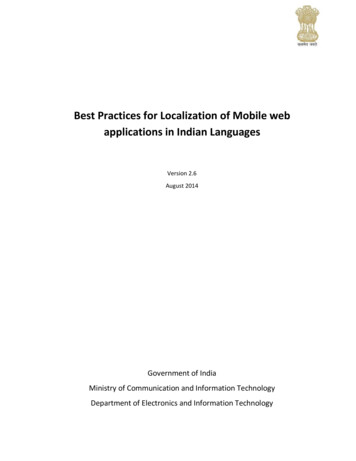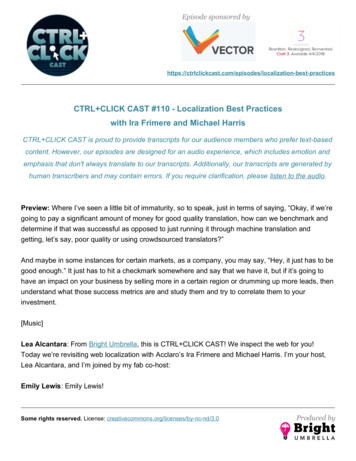
Transcription
Best Practices for Localization of Mobile webapplications in Indian LanguagesVersion 2.6August 2014Government of IndiaMinistry of Communication and Information TechnologyDepartment of Electronics and Information Technology
Metadata of the DocumentS. No.Data elementsValues1.TitleBest Practices For Localization of Mobile webapplications in Indian Languages.2.Title AlternativeL10N-MobiWeb3.Document Identifier(To be allocated at the time of releaseof final document )4.Document Version, month, yearof release2.6, August, 2014(To be allocated at the time of releaseof final document )5.Present Status6.Publisher7.Date of Publishing8.Type of Standard DocumentMinistry of Communication and InformationTechnology, Department of Electronics andInformation TechnologyBest Practice(Policy / Technical Specification/ BestPractice /Guideline/ Process)9.Enforcement CategoryRecommended( Mandatory/ Recommended)10.Creator(An entity primarily responsible formaking the resource)11.Contributor(An entity responsible for makingcontributions to the resource)Ministry of Communication and InformationTechnology, Department of Electronics andInformation TechnologyCentre for Development of Advanced Computing(CDAC), GIST, Pune, IndiaBest Practices for Localization of Mobile web applications in Indian Languages2
12.Brief DescriptionThis document discussed various guidelines to helpdevelopers to localize their software products /services on Mobiles. This document will benefitnew software developers in using the existingtechnologies together with various initiatives andstandards, which will help them, understand thecomplications involved with various scripts andplatforms. A further benefit is better integrationand interoperability of products. The documentbrings to limelight some national as well asinternational standards currently used in theLocalization industry. Various important topics havebeen touched in this document like Inputting,storage and rendering Indian language data,Unicode migration from legacy data, Usage ofCommon Locale Data Repository (CLDR),Characters encoding for proper representation onvarious platforms, Unicode, directionality issueswith right to left scripts such as Urdu and theproblem of using Cascading Style Sheets (CSS ) incontext Indian languages.Frequently Used Entries for Localization (FUEL) forterm consistency as an open source initiative, incontext of Indian language has been cited. VariousISO 639 Language Codes have been provided at theend of the document. However, some of theguidelines are generic in nature and may or maynot be applicable to mobile platforms.13.Target AudienceThis document is intended for:(Who would be referring / usingthe document)Software Designers / Engineers, Testing and QAEngineers , Mobile App Developers and VASProviders and Policy makers14.Owner of approved standardMinistry of Communication and InformationTechnology, Department of Electronics andInformation Technology15.SubjectLocalisationBest Practices for Localization of Mobile web applications in Indian Languages3
(Major Area of Standardization)16.Subject. CategoryMobile Web(Sub Area within major area )17.Coverage. SpatialAll stakeholders involved in the process ofLocalisation18.FormatDOCX, PDF19.LanguageEnglish (To be translated in other Indianlanguages later)(To be translated in other Indianlanguages later)20.CopyrightsMinistry of Communication and InformationTechnology, Department of Electronics andInformation Technology21.SourceAdapted from and partly based on the referencesprovided in section 19: References(Reference to the resource from whichpresent resource is derived)22.Relation(Relation with other e-Governancestandards notified by DeitY)W3C recommendations, Enhanced INSCRIPTKeyboard have been used and references in thisdocumentBest Practices for Localization of Mobile web applications in Indian Languages4
Amendments LogOld Version No,Month and YearBriefing about changerequest and action takenNew Version No,Month and YearThe sections , which have beenrevised or New section added1.1 October 2012Draft Version1.2 November 2012Draft Prepared1.2 November 2012Based on feedback1.3 November 2012Section on Complexities inIndian languages Added1.3 November 2012Based on feedback1.4 November 20123GPP Standard Added1.4 November 2012Based on feedback1.5 December 2012Internet Browsing section added1.5 December 2012Based on feedback1.6 December 2012CSS section modified1.6 December 2012Based on feedback1.7 December 2012Added Acronyms &Abbreviations1.7 December 2012Based on feedback1.8 December 2012Added Annexure I1.8 December 2012Based on feedback1.9 January 2012Modified Device Specificguidelines section1.9 January 2014Based on feedback2.0 January 2014Modified ApplicationSpecification guidelines section2.0 January 2014Based on feedback2.1 January 2014Modified ApplicationSpecification guidelines section2.1 January 2014Based on feedback2.2 January 2014Modified ApplicationSpecification guidelines section2.2 January 2014Based on feedback2.3 February 2014Restructuring done based onfeedback2.3 February 2014Based on feedback2.4 February 2014Restructuring done based onfeedback2.4 February 2014Based on feedback2.5 March 2014Template Added2.5 March 2014Based on Feedback by EGov LocalizationCommittee2.6 July 2014Restructured based on thefeedbackBest Practices for Localization of Mobile web applications in Indian Languages5
Important informationMany legacy and existing e-Governance applications are based on proprietary tools, technologiesand database formats. Few of these also form part of some of the Mission Mode Projectsenvisaged under the NeGP. Therefore, to cater to the requirements of such applications the scopeof this document has been kept broad, also to include specific sections on proprietary software.Under National e-Governance Plan (NeGP) for all software applications being currently plannedand developed for delivering e-Governance services and solutions, the Government of Indiahowever strongly recommends adherence to Open Standards while taking decisions on the use oftools, technologies and database formats .All stakeholders are thus exhorted to contribute to thecause of open standards to help ensure seamless integration of services and sharing of data acrossdifferent e-Governance applications and services."Best Practices for Localization of Mobile web applications in Indian Languages6
ContentsContents . 71Introduction . 91.1Outline . 91.2Purpose of this Document. 91.3Scope . 101.4Background. 101.5Sophistication of Indian Scripts . 111.6Indian languages on mobiles: . 132Target Audience. 143Type of Standard Document & Enforcement Standard form. 144Definition and Acronyms . 145Guidelines . 156Application Specific Guidelines . 156.1Mobile Web Best Practices . 156.2Default Delivery Context . 186.3Implementation notes regarding localization of web based forms . 196.4Normalization in Unicode. 196.5User Input . 206.6Mobile SVG . 206.7Mobile CSS . 216.8Listing in CSS . 226.9CSS rendering Issues in Indic Script . 236.10 XHTML for Mobile . 296.11 Inherent Indian languages support . 29Best Practices for Localization of Mobile web applications in Indian Languages7
6.12 Internationalized domain names (IDN): . 297Mobile OK Checker/ Validator . 318ISO 639 Language Codes. 329Localization . 339.1Frequently Used Entries for Localisation (FUEL) . 339.2Common Locale Data Repository (CLDR) . 349.3Indic Based Cursor Movement, addition and deletion . 359.4Directionality . 389.5Collation Order . 389.6Script Behaviour for Hindi . 3910 Other Generic Guidelines for mobile Apps . 40Annexure I: Device Specific Guidelines . 42Annexure II: Acronyms and Abbreviations . 49Annexure III: References . 50Best Practices for Localization of Mobile web applications in Indian Languages8
1 Introduction1.1 OutlineThe means to access the internet are changing from a desktop to mobile by the rapid change inthe technology. This situation not only opens interesting new avenues to content publishers toreach as many users as possible on mobile devices, but also brings with it many challenges to dealwith when we consider language support, especially the complex Indian scripts on these devices.From the beginning of the development, the Standard bodies have seen the need of mobile webstandards in order to optimize the web user experience on small and constricted mobile devices.However, they have not been able to keep pace with the drastic changes on the hardware front,having many standards that do not reflect and exploit the new hardware situation. This lack ofgoverning mobile standard results in a paradigm shift on mobile devices; a very interactive andrich Web 2.0 website on the desktop web, where a browser-based experience is common, veryoften does not provide the same functionality through mobile web.The intent of this document is to discuss localization in Indian language perspective for mobiledevices and the concepts involved in localization like: inputting, storage, display, communicationprotocols, CLDR (Common Locale Data Repository), Collation Order, Hyphenation rules, Cursormovement rules, addition deletion rules, bidi (Bi-directional) algorithm and many more. It alsoprovides a set of guidelines which is broadly classified under the heading “Application SpecificGuidelines”.The document also summarizes the basic components of Indian Language (IL) solution and the roleof the embedded device manufacturer to integrate IL solution into the system. It has beenobserved that for enabling IL on various platforms across the world, the required corefunctionality to enable IL is highly proprietary in nature, very complex, tightly coupled with theperformance of device and is not generic at all.1.2 Purpose of this DocumentThis document is intended for application developers, quality assurance, and also handset/devicemanufacturers and all the stakeholders for seamless interoperability. This document can also beused as a guideline by various Government of India departments like e-Governance etc. forensuring that their various schemes/initiatives are seamlessly provided on mobile/tablet platformsin Indian languages.Best Practices for Localization of Mobile web applications in Indian Languages9
1.3 ScopeThe scope of this document is to lay down guidelines or best practices to be followed for mobileapplication development esp. in view of Indian Languages. The scope of this document is tocreate awareness among the software developers and the designers to create localizedapplications/products. There are some coding snippets / examples which are used to illustrate theconcept; however they are not intended as a guide to implementation. Some of the guidelines aregeneric in nature and may be followed as per the requirement.The document focuses only on HTML 5 based forms for mobile applications. The other standardforms are not under the scope of this document.1.4 BackgroundIndia is a multilingual country with 22 scheduled languages and 12 different scripts. The scheduledlanguages of India are Assamese, Bangla, Bodo (Boro), Dogri, Gujarati, Hindi, Kannada, Kashmiri,Konkani, Maithili, Malayalam, Manipuri, Marathi, Nepali, Odia (Oriya), Panjabi (Punjabi), Sanskrit,Santali, Sindhi, Tamil, Telugu and Urdu. The scripts which are widely used are:Bengali, Devanagari, Gujarati, Gurmukhi, Kannada, Malayalam, Meitei Mayek, Ol-Chiki, Oriya,Perso-Arabic, Tamil, and Telugu. To support all these languages on a mobile device is a majorchallenge.The complexity of Indian scripts in terms of inputting, storage and display has been the majorchallenge while giving support of Indian languages on mobiles. Traditionally when mobiles startedarriving in the market, the main focus was on roman like scripts and more complex scripts werealways a afterthought. The entire ecosystem of the mobile handset including hardware, operatingsystem, applications, communication protocols such as SMS etc, were designed keeping the focuson roman like scripts. The limited 12 keys on the physical keypad have always posed a dauntingchallenge to input Indian languages. In attempt to overcome this challenge and come with quicksolution, many vendors/handset manufacturers have implemented their own version of keyboardlayout. User is finding it difficult to get accustom to so many proprietary keyboards. It is evenmore difficult for the users to shift their inputting style if they change the mobile handset ofdifferent vendor. Hence, there is an urgent need to standardize the keyboards of allvendors/manufacturers.The storage and display of Indian languages are greatly linked with inputting. In fact, all threecomponents are inter-dependant and cannot be considered in isolation. There have been manyproprietary storage formats used by the vendors in the past; however Unicode has becomeBest Practices for Localization of Mobile web applications in Indian Languages10
accepted standard. The vendors are rather slow in adapting to revisions of Unicode for Indianscripts. This creates the compatibility issue when data is migrated to-and-from the mobile todesktop/internet and vice versa. Display of Indian languages is mostly governed by theapplications. The applications like browsers have their own complex script renderers where asother applications depend on system wide implementation of Indian scripts. This has created arather difficult situation to the users, wherein on the same mobile handset, user may have to usetwo-or-more different implementations of Indian languages; with one being systemimplementation provided by the mobile vendor/manufacturer and other is application specificimplementation like browser etc. This is confusing to the users and sometimes may lead to usersturning away from Indian language usage on mobiles.1.5 Sophistication of Indian ScriptsAlphabets for Indian languages are highly developed and have a highly evolved system oforganization, coding of sounds, and the system of writing.The alphabet is organized scientifically based on position of tongue and aspiration of breath as youspeak a sound. It is phonetic- where you speak what you write directly correlated to individualaksharas. As a result, deviations between speaking and writing, if any, which have crept indifferent Indian languages are more predictable and systematic than say with Roman alphabet andEnglish.The script (the actual writing of the characters in a sequence) evolved from the Brahmi script andis highly sophisticated. It is not just a placement of the characters one after another like in Romanscript. The graphemes for vowels following the graphemes for consonants are systematicallymerged into an akshara (consisting of graphemes for maatraas and consonant clusters).This sophistication in writing became a problem, unfortunately, because the initial rudimentarycomputer technology was unable to handle it.The display technology evolved with True Type Font (TTF) technology to incorporate variablewidth fonts richer than the typewriter. Though ISCII (Indian Standard Code for InformationInterchange) the BIS standard was already in place in the year 1988 itself, it was never mademandatory for all the Operating Systems / Applications to follow it. TTF technology although goodin display of shapes, was incapable of rendering the sophisticated Indian scripts. As a result,developers using this insufficient technology were forced to adopt work-around which led tostorage of data in their respective proprietary font code (TTF). As a result, for a dark period lastingabout 27 years, OS / applications including graphic display software technology was unable tohandle Indian scripts properly for want of software implementation, even when it wasBest Practices for Localization of Mobile web applications in Indian Languages11
technologically possible as demonstrated through GIST technology. Unfortunately, the workaround solution did violence to our scripts rendering text keyed-in by this method non-displayableacross schemes, as well as it led to the proliferation of non-standard representation in memoryand keyboard layouts. Indian languages are still recovering from this damage, due to proliferationof non-standards during this dark period.With the Open Type Font technology which was developed specifically to handle Indian and othersophisticated scripts, the earlier technology lacuna was finally overcome. However, theproliferation of inputting using different keyboards still remains a problem as different people gotused to different types of keyboards.In the Indian scripts, a sequence of consonants is not just placed left to right but combines to forma consonant cluster. It is more compact and takes less space to display. It requires a longerlearning time, but is faster to read. Vowels following a consonant cluster are put as matra (ordiacritic) on the cluster which again shows the sophistication of the scripts. Such a unit is called anakshara and is like a syllable. The aksharas are placed left to right one after another. Thus, thescript’s basic unit or atom is the character (vowel or consonant) like in Roman, and is used forinputting as well as pronunciation. However, these atoms are put together into molecules oraksharas (or syllables) by a complex process. Once an akshara is formed, it is displayed after theprevious akshara from left to right in a simple manner.The formation of consonant clusters has a visually appealing and an intuitive process, butcapturing such language processes in rules has always been a challenging task. This has beenachieved in OTF technology by making provision for rules as well as pre-stored forms in tables.The inputting proceeds by typing of characters. Each character has a well defined sound which itstands for. The characters are typed in the order in which the sounds occur. The display proceedsby composing each akshara by complex rules, and the akshara themselves are placed from left toright one after another.While characters are being input, an akshara is being formed dynamically for displaying. Thecorrespondence between the characters input and the form being displayed is not always one toone. Therefore, one needs to learn not just the individual characters but also how the aksharaslook. Backspace deletes the entire last akshara and not just the last character.The guidelines here are to make it easier and aesthetically more pleasing to process and work withIndian scripts.Best Practices for Localization of Mobile web applications in Indian Languages12
1.6 Indian languages on mobiles:Inputting of Indian language text on mobiles also requires a special keyboard driver to interpretIndian language text entry. Such keyboard driver can allow direct Indian language inputting, likeEnhanced INSCRIPT (http://pune.cdac.in/html/gist/down/inscript d.asp), phonetic like inputting(where IL is entered by using English keypad e.g. ghar ja raha tha), Multitap, CDAC’s two keymechanism.Some existing standards like Enhanced INSCRIPT should be referred for mobile based inputting.Also IL alphabets are required to be should be engraved on the keys of the mobile device. Formobile devices having touch screen interfaces only and where the screen size is small, 12-KeyVirtual Keyboard inputting mechanism should be preferred. For smart phones where the screensize is more than 3 inches (measured diagonally) INSCRIPT based Virtual Keyboard should bepreferred.This document discusses guidelines for mobile devices along with the basic needs required tolocalize a piece of text i.e. input, storage, display and communication.Best Practices for Localization of Mobile web applications in Indian Languages13
2 Target AudienceThis document is intended for:Software Designers / Engineers: To understand and evaluate Localization areas related to productdesign.Testing and QA Engineers:Internationalization in mind.To define test plans and test cases keeping Localization andMobile App Developers and VAS Providers: To ensure seam less Indian languages support.Policy Makers: To ensure policy level requirements for Indian Language support for MobileEcosystem3 Type of Standard Document & Enforcement Standard formThis document, as the name suggests, provides norms and recommendations termed as BestPractices for L10N. L10N for Mobile web requires a common minimum requirement for allstakeholders and this is the major aim of this document. Govt. Bodies or third party developerswould use this document to create L10N in all the constitutionally recognized languages to ensurethat that they get the widest outreach possible. This document is more in the form ofrecommendations and provides norms for the purpose of L10N in mobile Applications.4 Definition and AcronymsFor definitions and acronyms please refer Annexure 3.Best Practices for Localization of Mobile web applications in Indian Languages14
5 GuidelinesThe guidelines mainly focuses on mobile application development under the heading “ApplicationSpecific Guidelines”. However to complete the device requirements, the Related aspects of devicelevel issues are covered in the Annexure – I6 Application Specific GuidelinesApplication specific guidelines could be divided into two categories viz.,i) W3C Mobile web best practices (MWBP) & other related W3C guidelines. The details aregiven in the next sectionii) Inherent Indian languages support.6.1 Mobile Web Best PracticesThe Mobile Web Best Practices, a set of recommendations released by the W3C in 2008, are notjust about technical issues like the use of standards for the mark-up or style sheets, but also toimprove the user experience in accessing the web from mobile devices. The goals of the BestPractices are a pleasant and functional presentation of the content, simplification in the inputprocedure, efficiency in bandwidth and costs, achieve user goals, ensure an effective space foradvertising and work towards a "One Web" experience, where the same information is availableacross all devices. W3C has developed a number of Web technologies that explicitly take intoaccount the specificities of mobile devices:Visit http://www.w3.org/TR/2008/REC-mobile-bp-20080729/ for more details.The generalized Web Architecture for representation various mobile and wireless devices is asdepicted below:Best Practices for Localization of Mobile web applications in Indian Languages15
MobileDevicesFig1. Generalized Mobile Web ArchitectureStandards that are specifically adhered for seamless mobile applications development can bedivided in the following categories1. Graphics2. Multimedia3. Device Adaptation4. Forms5. User interactions6. Data storage7. Sensors and hardware integration8. NetworkThe W3C specifications / recommendations that may be adopted for mobile web developmentcorresponding to each of the above categories are listed in the table:Best Practices for Localization of Mobile web applications in Indian Languages16
Sl No.Category1.Graphics2.Multimedia(Video andAudio Playback)3.W3C Specification(1) Scalable Vector Graphics(SVG) 1.1(2) CSS Backgrounds andBorders(1) Video playback(2) Audio PlaybackReferences(1) http://www.w3.org/TR/SVG11/(2) http://www.w3.org/TR/css3-background/(1) the-video-element(2) the-audio-element(1) onForms(1) Device DescriptionRepository Simple API(1) Forms Control5.UserInteractions(1) Touch Event Control(2) Input Method Editor API(1) http://www.w3.org/TR/touch-eventsextensions/(2) http://www.w3.org/TR/ime-api/6.Storage(1) Web Storage(1) http://www.w3.org/TR/webstorage/7.Sensors andHardwareIntegrationNetworkInformation(1) ) WebRTC 1.0: Real-timeCommunication r/webrtc.html4.8.(1) http://www.w3.org/TR/html5/forms.htmlBest Practices for Localization of Mobile web applications in Indian Languages17
6.2 Default Delivery ContextFig.2 Delivery Context for Mobile ApplicationsIn order to allow content providers to share a consistent view of a default mobile experience theBPWG has defined the Default Delivery Context. This allows providers to create appropriateexperiences in the absence of adaptation and provides a baseline experience where adaptation isused. The Default Delivery Context is the minimum delivery context specification necessary for areasonable experience of the Web on Mobile platform. This specification is made against thebackground of demographic, cultural and economic assumptions. The Default Delivery Contextspecification as follows: Usable Screen Width - 120 pixels, minimum. Markup Language Support - XHTML Basic 1.1 [XHTML-Basic] delivered with content typeapplication/xhtml xml. Character Encoding - UTF-8 Maximum Total Page Weight – 40 KB (International recommendation is 20 KB however dueto multiple byte requirement of Indian languages. It has been investigated that these willrequire 40 KB) Image Format Support – JPEG 2000 (Although GIF 89 A is allowed as per MWPB but toavoid network load only JPEG is recommended.Best Practices for Localization of Mobile web applications in Indian Languages18
Colors - 256 Colors, minimum. Style Sheet Support - CSS 2.1 HTTP 1.0/ 1.1 Script - no client side scripting is recommended due to device limitations.6.3 Implementation notes regarding localization of web based formsA form is a component of a Web page that has form controls, such as text fields, buttons,checkboxes, range controls, or color pickers. A user can interact with such a form, providing datathat can then be sent to the server for further processing (e.g. returning the results of a search orcalculation). No client-side scripting is needed in many cases, though an API is available so thatscripts can augment the user experience or use forms for purposes other than submitting data to aserver.Browsers are encouraged to use user interfaces that present dates, times, and numbers accordingto the conventions of either the locale implied by the input element's language or the user'spreferred locale. Using the page's locale will ensure consistency w
Software Designers / Engineers , Testing and QA Engineers , Mobile App Developers and VAS Providers and Policy makers 14. Owner of approved standard . Best Practices for Localization of Mobile web applications in Indian Languages 10 1.3 Scope The scope of this document is to lay down guidelines or best practices to be followed for mobile .










